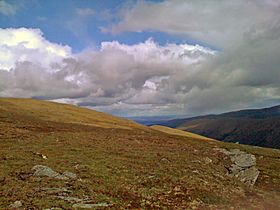Eagle Summit (Alaska) facts for kids
Quick facts for kids Eagle Summit |
|
|---|---|

The east slope of Eagle Summit, seen looking north in summer 2008.
|
|
| Elevation | 3,652 ft (1,113 m) |
| Traversed by | Steese Highway |
| Location | Southwest of Central, Alaska, Yukon-Koyukuk Census Area |
| Range | White Mountains |
| Coordinates | 65°29′04″N 145°24′13″W / 65.48444°N 145.40361°W |
Eagle Summit is a mountain pass in central Alaska. It is about 3,652 feet (1,113 meters) high. This gap cuts through the White Mountains. People who were looking for gold, called prospectors, named it after the nearby Eagle River. They came from a town called Circle, Alaska.
Eagle Summit is a special place where two different weather areas meet. These are the Yukon Flats to the north and the Tanana Valley to the south. When the weather is different in these two valleys, it can cause strong winds and a lot of snow or rain.
What Makes Eagle Summit Special?
Eagle Summit is known for its very strong winds and heavy snow. In 1916, a famous climber named Hudson Stuck described it. He said it was one of the hardest passes in Alaska. He wrote that the wind blew so hard it was almost impossible to cross for days. The snow would pile up, changing the path after every storm. He also noted there was no easier way around it.
The Steese Highway and Eagle Summit
Because it was the only way through, engineers chose Eagle Summit for the Steese Highway. This road connects Fairbanks, Alaska to Circle, Alaska on the Yukon River. In 1927, the highway was finished. This was just 11 years after Hudson Stuck traveled over it by dog sled.
Today, Eagle Summit is still the highest point on the Steese Highway. Many people visit to see its beautiful views. It is also a place where you can see the Midnight sun around the summer solstice. This happens even though it's south of the Arctic Circle, because it's so high up.
Eagle Summit and the Yukon Quest Race
Eagle Summit is also a key part of the annual Yukon Quest sled dog race. This race is 1,000 miles long. The strong winds, deep snow, and steep hills make it the hardest part of the race. Some racers even say it's the toughest section in any sled dog race in the world.
In 2006, a very bad storm hit Eagle Summit during the race. The snow was so thick that racers couldn't see anything. Seven mushers (dog sled drivers) and their dog teams had to be rescued by helicopter. Because of this storm, only 11 mushers finished the race. This was the fewest finishers in the history of the Yukon Quest.

